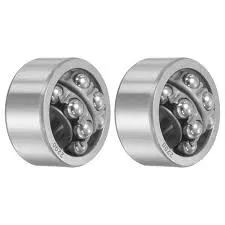
Nov . 24, 2024 21:56 Back to list
Understanding Angular Contact Bearings and Their Applications in Engineering
Understanding Angular Contact Ball Bearings Design, Applications, and Benefits
Angular contact ball bearings are a type of rolling-element bearing that can accommodate both axial and radial loads, making them essential components in various mechanical systems. These bearings are distinguished by their unique design, which allows for higher speed and increased load-carrying capability compared to deep groove ball bearings. In this article, we will explore the design, applications, advantages, and considerations associated with angular contact ball bearings.
Design and Features
The primary characteristic of angular contact ball bearings is the angle of contact between the balls and the raceways. This contact angle is usually greater than zero degrees, which means that the load is transferred between the balls and the races at a specific angle. Common contact angles include 15°, 25°, and 40°, with each angle offering different load capacity and axial load handling capabilities.
Angular contact ball bearings consist of an inner ring, an outer ring, a set of balls, and a cage that maintains the position of the balls within the raceways. The raceways are ground to high precision, which ensures smooth and efficient rotation. The internal design often features higher rigidity and the ability to handle combined loads—be it axial, radial, or a combination of both.
Applications
Angular contact ball bearings are utilized in a myriad of applications across various industries. Key applications include
1. Machine Tool Spindles Due to their ability to support high speeds and withstand radial and axial loads, these bearings are essential for precision machining.
2. Automotive They are commonly used in various automotive components like transmissions and wheel hubs, where high reliability and performance are crucial.
3. Aerospace In rotating equipment such as jet engines, angular contact ball bearings ensure efficient performance under demanding conditions.
4. Electric Motors These bearings are ideal for electric motors used in industrial applications, where space is limited, and high performance is required.
5. Robotics Angular contact ball bearings are also critical in robotic joints and actuators, providing the necessary precision and speed for complex movements.
Advantages
The design and functionality of angular contact ball bearings offer several advantages
angular contact ball

- High Speed Capability The low friction offered by these bearings allows for higher rotational speeds, making them suitable for high-speed applications.
- Loading Versatility They can handle both radial and axial loads, giving them a versatile application scope.
- Precision With tight tolerances and high levels of preloading, angular contact ball bearings provide excellent precision and enhanced performance, which is crucial for many applications.
- Durability These bearings often exhibit higher durability compared to other types of bearings, which can lead to reduced maintenance costs and longer service intervals.
Considerations
While angular contact ball bearings provide many advantages, there are some considerations to bear in mind
1. Installation Precision installation is critical to achieve optimal performance. Misalignment can lead to early failure of the bearing.
2. Load Rating It’s essential to choose the correct bearing size and contact angle based on specific load requirements to avoid overload situations.
3. Lubrication Proper lubrication is vital to reduce friction and wear. It is important to choose the right type of lubricant based on the operating environment.
4. Cost Angular contact ball bearings can be more expensive than standard bearings due to their specialized design and manufacturing process.
Conclusion
Angular contact ball bearings play a crucial role in modern engineering and machinery. Their ability to handle combined loads while maintaining high-speed performance makes them a preferred choice in various applications. By understanding the design features, applications, advantages, and considerations associated with these bearings, engineers and designers can make informed decisions that enhance the efficiency and reliability of their systems.
As industries evolve and push the boundaries of technology, the demand for high-performance components like angular contact ball bearings will undoubtedly continue to grow. Their importance in both everyday machinery and advanced technology applications underscores the need for ongoing research and development in bearing technology to meet future challenges.
Latest news
-
Grooved Ball Bearing Design and Functionality
NewsJun.04,2025
-
Concrete Mixer Bearing Load Capacity Testing
NewsJun.04,2025
-
6004 Bearing Dimensions in Robotic Joint Designs
NewsJun.04,2025
-
Advantages of Single-Row Deep Groove Ball Bearings
NewsJun.04,2025
-
Applications of Deep Groove Ball Bearings in Automotive Systems
NewsJun.04,2025
-
Innovations in Bearing Pressing Machine Design
NewsJun.04,2025
